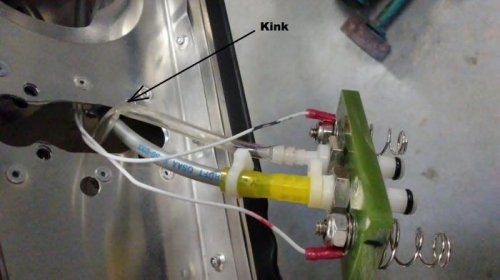
|

|
|

|
Johns Web Site

|
Date: 8-7-2017
|
Number of Hours: 0.00
|
Manual Reference:
|
Brief Description: Static Source Problem
|

|
The cause of the static source problem uncovered during the first flight has been diagnosed and fixed.
After pulling the static tube from the static manifold located behind the instrument panel, it was quickly determined that the static port was plugged. To find the source of the obstruction, the left wing was pulled (a two minute job,) opening the pitot and static connection at the wing-to-fuselage intersection. With that connection opened, the static port tubing through the fuselage was found flow air easily, meaning the problem was in the wing.
Looking into the end of the wing, it was discovered that the service loop that allowed the wing side of the Pitot/Static port connector to be pulled out for service, had developed a kink, blocking air flow through the tubing. See the attached photo. It was obvious that this type of tubing was not flexible enough to conform to the required radius behind the connector without kinking.
The wing was flipped over for easier access to the inspection panel in the center of the wing, near the termination of the static tube. The tube was disconnected from both ends and removed from the wing. It was replaced with a tougher Polyethylene tube. The inboard end of the static tube was connected to a piece of very flexible Tygon tubing, capable of being formed to the needed radius without kinking. This assembly was tested, and it allowed air to flow easily.
Everything was reassembled and the static system passed air easily. The pitot system was also checked and found to be leak free. The plane is ready for another test flight as soon as the weather and my schedule align.
|

|

Kink In Static Tube
|

|
|

|

|

|
|

|

|
Copyright © 2001-2024 Matronics. All Rights Reserved.
|

